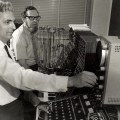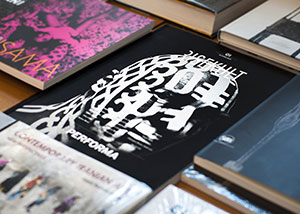If an atom gets excited in a laboratory, does it make a sound? Turns out that it absolutely does, albeit it’s the softest sound that scientists say is physically possible.
Researchers at Columbia University and Sweden’s Chalmers University of Technology say that they have, for the first time, “captured” the sound a single atom makes when it moves around—a single “phonon,” as it were. It’s an achievement that could eventually be used as the basic science for new quantum computing devices.
Like everyone is taught in elementary school, anytime something moves or vibrates, it makes a sound. Scientists now know for sure that that principle extends down to the lowly atom.
“The sound amplitude, or strength, is very weak,” said Göran Johansson, a co-author of the paper published today in Science. “Basically, when you excite the atom, it creates a sound, one phonon at a time, according to theory. It’s the weakest possible sound possible at the frequency [that it vibrates].”
IT’S KIND OF NEAT TO SEE WHAT HAPPENS WHEN YOU REPLACE LIGHT WITH SOUND
Ordinarily, this is the part in the story where we’d link to a clip of the atom’s audio, but it’s so soft that it’s not even audible, and the researchers weren’t able to actually hear it.
So, sorry about that. Instead, using a semiconducting circuit (similar to those used to make small quantum computers), Johansson and his team created an artificial atom (like those used in quantum experiments) and excited it.
Johansson told me that on the chip was a series of long metallic “fingers” that capture and measure the acoustic waves made by the atom’s vibrations. These are too small to see, so the waves—which look just like waves on a water’s surface, he told me—propagate to a second set of fingers that transform them into microwaves.
“These can then be detected using low-temperature microwaving amplifiers. It’s the same technology we use to read out superconducting qubits,” which are used in quantum communications, he said.
So, why do this? For one, the team wanted to simply see if it could capture the softest sound ever made, which is certainly a noble goal. But, secondly, the researchers wanted to explore the quantum nature of sound. Photons (particles of light) have always been used in quantum experiments, but they’re pretty hard to manipulate because they’re so fast.
“In comparison to photons, phonons have several striking features. Their speed of propagation is around 10^5 times lower, and their wavelength at a given frequency correspondingly shorter,” the researchers wrote in Science. “The slow speed means that qubits can be tuned much faster [than photons] … this enables new dynamic schemes for trapping and processing quanta.”
In other words, perhaps the future of quantum communications isn’t in quantum light, it’s in quantum sound: “You have time to modify the signal when it propagates,” Johansson told me.
For now, he says he’s focused on actually hearing the phenomenon and demonstrating its quantum nature. He says that, if he repeats the signal enough times, it may be possible to actually record the sound itself, rather than simply see its waves once they’ve been converted to microwaves.
“We thought this would be some nice curiosity-driven basic research,” he said. “It’s kind of neat to see what happens when you replace light with sound.”

























